CH-47 Chinook
| CH-47 Chinook | |
|---|---|
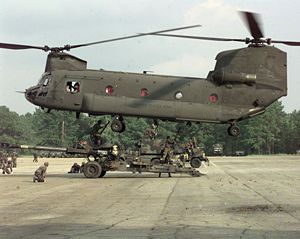 |
|
| Field artillery section sling loading an M198 howitzer for airlift by a CH-47 Chinook | |
| Role | Cargo helicopter |
| Manufacturer | Boeing Helicopters |
| First flight | 21 September 1961 |
| Introduction | 1962 |
| Status | Active service |
| Primary users | United States Army Australian Army Japan Ground Self Defence Force Royal Netherlands Air Force |
| Number built | more than 1,179[1] |
| Unit cost | $10.3 million (1999)[2] |
| Developed from | CH-46 Sea Knight |
| Variants | Boeing Chinook (UK variants) |
The Boeing CH-47 Chinook is a versatile, twin-engine, tandem rotor heavy-lift helicopter. Its top speed of 170 knots (196 mph, 315 km/h) was faster than utility and attack helicopters of the 1960s and even many of today. Its primary roles include troop movement, artillery emplacement and battlefield resupply. There is a wide loading ramp at the rear of the fuselage and three external-cargo hooks.
Chinooks have been sold to 16 nations; the largest users are the U.S. Army and the Royal Air Force, see Boeing Chinook (UK variants). The H-47 is now produced by Boeing Integrated Defense Systems.
Contents |
Design and development
Late in 1956 the Department of the Army announced plans to replace the CH-37 Mojave, which was powered by piston-driven engines, with a new, turbine-powered aircraft. A design competition was held and, in September 1958, a joint Army-Air Force source selection board recommended that the Army procure the Vertol medium transport helicopter. However, the necessary funds to proceed with full-scale development were not available and the Army vacillated in its design requirements. There were those in the Army who felt that this new helicopter should be a light tactical transport aimed at the mission of the old H-21s and H-34s and, consequently, sized for approximately fifteen troops. Another faction believed that the new transport should be much larger to serve as an artillery prime mover and have minimum interior dimensions compatible with the Pershing Missile system. This "sizing" problem was a critical decision.
The first Vertol prototype, called the YHC-1A, was tested by the Army to derive engineering and operational data. Three aircraft were built with a maximum troop capacity of twenty. This model eventually became Vertol's commercial Model 107 and the CH-46 Sea Knight. However, the YHC-1A was considered by most of the Army users to be too heavy for the assault role and too light for the transport role. The decision was made to procure a heavier transport helicopter and at the same time upgrade the Huey as a tactical troop transport. This decision was to determine the pattern of airmobile operations for the next decade. As a consequence, the Army concept of air assault operations differed from the Marines because, among many reasons, the very nature of the equipment demanded different methods of employment.[3]

The Army then ordered the larger Model 114/HC-1B. The pre-production Boeing Vertol YCH-1B made its initial hovering flight on September 21, 1961. In 1962 the HC-1B was redesignated the CH-47A under the 1962 United States Tri-Service aircraft designation system. The name "Chinook" alludes to the Chinook people of the Pacific Northwest.
The Chinook is powered by two turboshaft engines, mounted on either side of the helicopter's rear end and connected to the rotors by driveshafts. The counter-rotating rotors eliminate the need for an anti-torque vertical rotor, allowing all power to be used for lift and thrust. If one engine fails, the remaining engine can drive both rotors.[4]
The "sizing" of the Chinook was directly related to the growth of the Huey and the Army's tacticians' insistence that initial air assaults be built around the squad. There was a critical stage in the Huey program when the technicians insisted that we should not go beyond the UH-1B model with Bell; that there should be a new tactical transport "between" the Huey and medium transport helicopter. Major General von Kann and I fought a rear-guard action in a Pentagon battle to keep the Huey program viable. When it was decided to go to the UH-1D (after an awkward pause on the original "C" design), the proper Chinook size became apparent. By resolutely pushing for the Huey and the Chinook, the Army accelerated its airmobility program by years.[5]
A commercial model of the Chinook, the Boeing-Vertol Model 234, is used worldwide for logging, construction, fighting forest fires and supporting petroleum exploration operations. As of December 15, 2006 Columbia Helicopters, Inc. of Aurora, Oregon has purchased the Type Certificate of the Model 234 from Boeing.[6] Currently the company is seeking FAA issuance of a Production Certificate to produce parts with eventual issuance of a Production Certificate to produce aircraft.
The Chinook was also built under license by Elicotteri Meridionali (Agusta) in Italy and Kawasaki in Japan.
Operational history

The CH-47A Chinook entered service inThe Army finally settled on the larger Chinook as its standard medium transport helicopter and as of February 1966, 161 aircraft had been delivered to the Army. The 1st Cavalry Division had brought their organic Chinook battalion with them when they arrived in 1965 and a separate aviation medium helicopter company, the 147th, had arrived in Vietnam on 29 November 1965. This latter company was initially placed in direct support of the 1st Infantry Division.
The most spectacular mission in Vietnam for the Chinook was the placing of artillery batteries in perilous mountain positions that were inaccessible by any other means, and then keeping them resupplied with large quantities of ammunition. The 1st Cavalry Division found that its Chinooks were limited to 7,000 pounds pay load when operating in the mountains, but could carry an additional 1,000 pounds when operating near the coast. The early Chinook design was limited by its rotor system which did not permit full use of the installed power, and the users were anxious for an improved version which would upgrade this system.
As with any new piece of equipment, the Chinook presented a major problem of "customer education." Commanders, pilots and crew chiefs had to be constantly alert that eager soldiers did not overload the temptingly large cargo compartment. It would be some time before the using troops would be experts at sling loads and educated in such minor details as removing the gunner's sight from the artillery pieces. The Chinook soon proved to be such an invaluable aircraft for artillery movement and heavy logistics that it was seldom used as an assault troop carrier. The early decision to move to this size helicopter proved to be indisputably sound.[7]

During the Gulf War of 1991, 163 CH-47Ds served in Operations Desert Shield and Desert Storm.[8]
The CH-47D saw wide use in Operation Enduring Freedom in Afghanistan and Operation Iraqi Freedom in Iraq. The Chinook was used in air assault missions, inserting troops into fire bases and later bringing food, water, and ammunition. It is typically escorted by attack helicopters such as the Apache for protection. The CH-47D was particularly useful in the mountainous terrain of Afghanistan where high altitudes and temperatures limited the use of the Black Hawk.
Variants
CH-47A
The all-weather, medium-lift CH-47A Chinook was powered initially by Lycoming T55-L-5 engines rated at 2,200 horsepower (1,640 kW) but then replaced by the T55-L-7 rated at 2,650 hp (1,980 kW) engines or T55-L-7C engines rated at 2,850 hp (2,130 kW). The CH-47A had a maximum gross weight of 33,000 pounds (15,000 kg). A total of 349 were built.
ACH-47A
The ACH-47A was originally known as the Armed/Armored CH-47A (or A/ACH-47A). It was officially designated ACH-47A by US Army—Attack Cargo Helicopter—and unofficially "Guns A Go-Go"). Four CH-47A helicopters were converted to gunships by Boeing Vertol in late 1965. Three were assigned to the 53rd Aviation Detachment in South Vietnam for testing, with the remaining one retained in the U.S. for weapons testing. By 1966, the 53rd was redesignated the 1st Aviation Detachment (Provisional) and attached to the 228th Assault Support Helicopter Battalion of the 1st Cavalry Division (Airmobile). By 1968, only one gunship remained, and logistical concerns prevented more conversions. It was returned to the United States, and the program stopped. The ACH-47A carried five M60D 7.62x51 mm machine guns or M2HB .50 caliber machine guns, provided by the XM32 and XM33 armament subsystems, two M24A1 20 mm cannons, two XM159B/XM159C 19-Tube 2.75" rocket launchers or sometimes two M18/M18A1 7.62x51 mm gun pods, and a single M75 40 mm grenade launcher in the XM5/M5 armament subsystem (more commonly seen on the UH-1 series of helicopters). The surviving aircraft, Easy Money, has been restored and is on display at Redstone Arsenal, Huntsville, Alabama.[4][5][6]
CH-47B
CH-47B was powered by two Lycoming T55-L-7C 2,850 shp (2,130 kW) engines. The CH-47B featured a blunted rear rotor pylon, redesigned asymmetrical rotor blades, and strakes along the rear ramp and fuselage to improve flying characteristics. The Chinook could be equipped with two door-mounted M60D 7.62 mm NATO machine guns on the M24 armament subsystem and a ramp-mounted M60D using the M41 armament subsystem. Some CH-47 "bombers" were equipped to drop tear gas or napalm from the rear cargo ramp onto NLF (aka Việt Cộng) bunkers. The CH-47 could be equipped with a hoist and cargo hook. The Chinook proved especially valuable in "Pipe Smoke" aircraft recovery missions. The "Hook" recovered about 12,000 aircraft valued at over $3.6 billion during the war. 108 built.
CH-47C
The CH-47C featured more powerful engines and transmissions.[9] Three versions of the "C model" were built. The original "C" had Lycoming T55-L-7C engines delivering 2,850 shp. The "Super C" included Lycoming T55-L-11 engines delivering 3,750 shp, an upgraded maximum gross weight of 46,000 lb and a pitch stability augmentation system (PSAS). Due to difficulties with the T55-L-11 engines, which were hurriedly brought to war to increase payload, they were temporarily removed from the "Super C" prior to 1970 and the very reliable Lycoming T55-L-7C's were installed until the L-11 engine difficulties could be quantified and corrected. This L-7C engine configuration was affectionately referred to as the "baby C" although it was still a Super C. It still distinguished itself from the "C" in that it had PSAS, and an uprated maximum gross weight. The CH-47 A, B, and all variants of the C were not able to receive certification from the FAA for civil use due to the non-redundant hydraulic flight boost system drive. A redesign of the hydraulic boost system drive was incorporated in the CH-47D which allowed that model to achieve FAA certification as the Boeing Model 234. 233 CH-47Cs were built.

The CH-47 A, B, and all versions of the C saw wide use during the Vietnam war. They replaced the H-21 Shawnee in the combat assault support role.
The export version of the CH-47C Chinook for the Italian Army was designated "CH-47C Plus".
CH-47D
The CH-47D was originally powered by two T55-L-712 engines, but most are now fitted with the T55-GA-714A. Models CH-47A, CH-47B, and CH-47C, all used the same airframe, but later models featured upgraded engines. With its triple-hook cargo system, the CH-47D can carry heavy payloads internally and up to 26,000 pounds externally, for example, bulldozers and 40-foot containers, at speeds over 155 mph (250 km/h). In air assault operations, it often serves as the principal mover of the 155 mm M198 howitzer, 30 rounds of ammunition, and an 11-man crew. Like most US Army helicopters, the Chinook has advanced avionics and electronics, including the Global Positioning System.

Nearly all of the Army production CH-47D models were conversions from previous U.S. Army A, B, and C models. The last US Army D model built was delivered to the U.S. Army Reserve, located at Fort Hood, Texas, in early 2002.[10]
The RAF versions of the CH-47D are the Chinook HC2 and HC2A. The RAF later ordered eight Chinook HC3s, which is a low cost version of the MH-47E for the special forces operations role. They were delivered in 2001 but have not yet entered operational service.
The CH-47SD is a modified variant of the CH-47D, with extended range fuel tanks and higher payload capacities. It is in use by the Republic of Singapore Air Force, and the Republic of China. The CH-47DG is an upgraded version of the CH-47C for the Greek Army. The CH-47D is an upgraded version of the CH-47LR for the Republic of Korea Army.
MH-47D
The MH-47D variant was developed for special forces operations and has in-flight refueling capability, a fast-rope rappelling system and other upgrades. The MH-47D was used by US Army 160th Special Operations Aviation Regiment. 12 MH-47D helicopters were produced. 6 were conversions from CH-47A models and 6 were conversions from CH-47C models.[11]
MH-47E
The current model used by US Army Special Operations is the MH-47E. Beginning with the E model prototype manufactured in 1991, there were a total of 26 Special Operations Aircraft produced. All aircraft were assigned to the "Nightstalkers", home based at Fort Campbell Kentucky. E models were conversions from existing CH-47C model airframes. The MH-47E has similar capabilities as the MH-47D, but includes an increased fuel capacity similar to the CH-47SD and terrain following/terrain avoidance radar.[12]
CH-47F

The CH-47F, an upgraded D model, first flew in 2001. The first production model was rolled out on June 15, 2006 at the Boeing facility in Ridley Park, Pennsylvania, and had its maiden flight on October 23, 2006.[13] The CH-47F was designed to extend the service life of the Chinook class beyond 2030. Among its upgrades are new 4,868 shaft horsepower Honeywell engines, improved avionics, and an upgraded airframe with larger single-piece sections to reduce part count and need for fasteners.[14] The new milled construction will reduce vibrations, eliminate points of joint flexing, and reduce the need for inspections and repairs, and reduce maintenance costs. It is also expected to increase service life.[15] The CH-47F can fly at speeds of over 175 mph with a payload of 21,000 lb (9,530 kg).[16] The improved avionics include a Rockwell Collins Common Avionics Architecture System (CAAS) cockpit, and BAE's Digital Advanced Flight Control System (DAFCS).[14]
Boeing has delivered 48 F model helicopters to the United States Army; on August 26, 2008, Boeing announced that the Army has signed a five year contract, worth over $4.8 billion for 191 more, plus 24 options.[16] In February 2007 the Netherlands was the first international customer to order the F model, six helicopters were ordered to expand their current fleet to 17. These six helicopters will be equipped with an upgraded version of the Honeywell Avionics Control Management System (ACMS) cockpit.[17] Additional orders are expected from Canada, Italy and the United Kingdom.
MH-47G

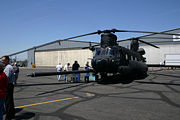
The MH-47G Special Operations Aviation (SOA) version is currently being delivered to the U.S. Army. It is similar to the MH-47E, but features a more sophisticated avionics including a digital Common Avionics Architecture System (CAAS). The CAAS is common glass cockpit used by different helicopters such as MH-60K/Ls, CH-53E/Ks, and ARH-70As.[18] The MH-47G will also incorporate all of the new sections of the CH-47F.[19]
Based on operational experience in Afghanistan, the CH-47 was found to be an effective substitute for the UH-60 Black Hawk as an assault helicopter. With its larger payload, range, and higher operating speed, one Chinook can replace up to five UH-60s in this role as an air assault transport.[20]
HH-47
On November 9, 2006, the HH-47, a new variant of the Chinook based on the MH-47G, was selected by the U.S. Air Force as the winner of the Combat Search and Rescue (CSAR-X) competition. Four development HH-47s will be built, with the first of 141 production aircraft to enter service in 2012.[21][22] However, as of February 2007 this contract award has come under scrutiny by the GAO and the USAF may recompete the CSAR-X project.[23] The HH-47D is a search and rescue version for the Republic of Korea Air Force.
Other export models
The CH-47J is a medium-transport helicopter for the Japan Ground Self Defence Force, and the Japan Air Self Defence Force. The CH-47JA is a long range version of the CH-47J, fitted with enlarged fuel tanks. Both versions are built under license in Japan by Kawasaki.
Eight CH-47C Chinooks were delivered to the Canadian Forces in 1974. The Chinooks were in Canadian service from 1974 to 1991; they were designated CH-147. These aircraft were subsequently sold to the Netherlands and are now operated by the Royal Netherlands Air Force as CH-47Ds. On July 5, 2006, the Canadian government issued a notice that it intends to purchase 16 CH-47F Chinooks.[24]

Civilian models
- Model 234LR (Long Range) - Commercial transport helicopter. The Model 234LR can be fitted out as an all-passenger, all-cargo, or cargo/passenger transport helicopter.
- Model 234ER (Extended Range) - Commercial transport version.
- Model MLR (Multi Purpose Long Range) - Commercial transport version.
- Model 234UT (Utility Transport) - Utility transport helicopter.
- Model 414 - The Model 414 is the international export version of the CH-47D. It is also known as the CH-47D International Chinook.
Derivatives
In the 1970s, the Army contracted Boeing to design a "Heavy Lift Helicopter (HLH)", designated XCH-62A. It appeared to be a scaled-up CH-47 without a conventional body, in a configuration similar to the S-64 Skycrane (CH-54 Tarhe), but the project was soon canceled. It was given a second examination in the 1980s and was again rejected. The scaled up model of the HLH was scrapped at the end of 2005 at Fort Rucker, Alabama.[25]
Operators
Military operators
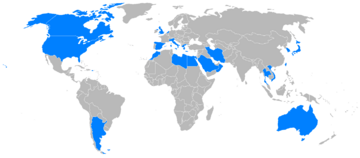
 Argentina
Argentina Australia
Australia Canada[26]
Canada[26] Egypt
Egypt Greece
Greece Iran
Iran Italy
Italy Japan
Japan Libya
Libya Morocco
Morocco Netherlands
Netherlands Republic of China (Taiwan)
Republic of China (Taiwan) Singapore
Singapore South Korea
South Korea
- Republic of Korea Air Force: HH-47D - introduced in December, 1991.
- Republic of Korea Army: CH-47D - introduced in September, 1988.
 Spain
Spain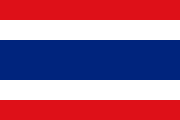 Thailand
Thailand Turkey (ordered 10)
Turkey (ordered 10) United Kingdom
United Kingdom - see Boeing Chinook (UK variants)
 United Arab Emirates
United Arab Emirates United States
United States Vietnam
Vietnam- captured ex-VNAF Chinooks
Civilian operators

- Helifor Canada Corp (under lease from Columbia Helicopters)
- Taiwan National Fire Administration (currently operates three 234s and nine CH-47SD)
- Civil Aviation Administration of China (one month demonstration period)[27]
- Icaro Air (under lease from Columbia Helicopters)
- CHC Helikopter Service (formerly Helikopter Services)
- British Airways Helicopters
- British International Helicopters
- Columbia Helicopters (currently operates seven 234s)
- Era Aviation
- NASA (August 14, 1979 - September 20, 1989)[28]
- Trump Airlines
Former civil operators are marked by italics
Notable accidents and incidents
- On September 11, 1982, at an airshow in Mannheim, Germany a United States Army Chinook (serial number 74-22292) carrying parachutists crashed, killing 46 people.[29] The crash was later found to be caused by an accumulation of ground walnut shells that had been used to clean the machinery.[30]
- On November 6, 1986, a British International Helicopters Chinook crashed on approach to Sumburgh Airport, Shetland Islands resulting in the loss of 45 lives and the withdrawal of the Chinook from crew servicing flights in the North Sea.[31]
- On 2 June 1994 an RAF Chinook HC2 (registration ZD576, call sign F4J40) crashed on the Mull of Kintyre, Scotland, killing all twenty five passengers and all four crew.
Specifications (CH-47D)
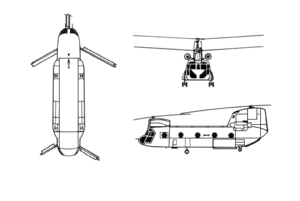

Data from Boeing CH-47D/F,[32] Army Chinook file,[33] International Directory[34]
General characteristics
- Crew: 3 (pilot, copilot, flight engineer)
- Capacity:
- 33-55 troops or
- 24 litters and 3 attendants
- 28,000 lb (12,700 kg) cargo
- Length: 98 ft 10 in (30.1 m)
- Rotor diameter: 60 ft 0 in (18.3 m)
- Height: 18 ft 11 in (5.7 m)
- Disc area: 2,800 ft² (260 m²)
- Empty weight: 23,400 lb (10,185 kg)
- Loaded weight: 26,680 lb (12,100 kg)
- Max takeoff weight: 50,000 lb (22,680 kg)
- Powerplant: 2× Lycoming T55-GA-712 turboshaft, 3,750 hp (2,796 kW) each
Performance
- Maximum speed: 170 knots (196 mph, 315 km/h)
- Cruise speed: 130 kt (137 mph, 220 km/h)
- Range: 400 nmi (450 mi, 741 km)
- Service ceiling 18,500 ft (5,640 m)
- Rate of climb: 1,522 ft/min (10.1 m/s)
- Disc loading: 9.5 lb/ft² (47 kg/m²)
- Power/mass: 0.28 hp/lb (460 W/kg)
Armament
M134 7.62 mm (0.308 in) minigun, M240 7.62 mm (0.308 in) machine gun
Avionics
Rockwell CAAS (MH-47G/CH-47F)
See also

- U.S. Army Aviation and Missile Command
Related development
- CH-46 Sea Knight
- Boeing Chinook (UK variants)
Comparable aircraft
- CH-53 Sea Stallion
- S-64 Skycrane
- CH-54 Tarhe
Related lists
- List of active United States military aircraft
References
- ↑ CH-47D/F Chinook page, Boeing
- ↑ CH-47/MH-47 Chinook Helicopter, About.com - CH-47/MH-47 Chinook Helicopter
- ↑ "Vietnam Studies, Airmobility 1961-1971" (.html). Department of the Army (1989). Retrieved on 2008-11-13.
- ↑ Chinook Information and diagrams about the transmission system
- ↑ "Vietnam Studies, Airmobility 1961-1971" (html). Department of the Army (1989). Retrieved on 2008-11-13.
- ↑ "Type Certificate Data Sheet No. H9EA" (.pdf). Federal Aviation Administration (January 17, 2007). Retrieved on 2007-02-08.
- ↑ "Vietnam Studies, Airmobility 1961-1971" (.html). Department of the Army (1989). Retrieved on 2008-11-13.
- ↑ "CH-47D/MH-47E Chinook". Army Technology. SPG Media Limited (©2006). Retrieved on 2006-08-27.
- ↑ US Army CH-47A / CH-47B / CH-47C / CH-47D / SOA Chinooks, vectorsite.net, 1 July 2004.
- ↑ Boeing CH-47D model Chinook helicopters
- ↑ Boeing MH-47D model Chinook helicopters
- ↑ Boeing MH-47E model Chinook helicopters
- ↑ "New Boeing CH-47F takes flight", Aerotech News and Review, November 3, 2006, p. 3.
- ↑ 14.0 14.1 "Boeing's New CH-47F Chinook Helicopter Begins Operational Test Flights with U.S. Army", Boeing, February 19, 2007.
- ↑ Holcomb, Henry, "New Look Chinook", Philadelphia Inquirer, August 17, 2007. archive link
- ↑ 16.0 16.1 "Boeing Awarded US Army Contract for 191 CH-47F Chinook Helicopters", Boeing, August 26, 2008.
- ↑ "Boeing Signs Contract for Dutch Chinooks", Boeing, February 15, 2007.
- ↑ Warwick, Graham. "Chinook: CAAS unites rotorcraft cockpits", Flight International, 1 April 2008.
- ↑ MH-47E/G Special Operations Chinook product page, Boeing.
- ↑ Air Transportation: Chinook Replaces Blackhawk in Combat
- ↑ [1] Boeing News Release
- ↑ [2] Global Security.org
- ↑ [3] Bowing To GAO, USAF Likely To Recompete CSAR-X 28 February 2007
- ↑ Medium to Heavy Lift Helicopter (MHLH) - ACAN MERX Website - Government of Canada
- ↑ XCH-62 with photo
- ↑ Canadian military acquiring new helicopters, drones
- ↑ Boeing: History - Products - Boeing Model 234 Chinook
- ↑ SP-3300 Flight Research at Ames, 1940-1997
- ↑ Air show safety in the spotlight, BBC, 27 July 2002.
- ↑ Ursula J. Schoenborn v. The Boeing Company, 769 F.2d 115 (3d Cir. 1985) - a case in the U.S. Court of Appeals for the Third Circuit
- ↑ Accident Report 2/88 Report on the accident to Boeing Vertol 234 LR, G-BWFC 2.5 Miles east of Sumbrugh, Shetland Isles on 6 November 1986
- ↑ Boeing CH-47D/F Specifications
- ↑ US Army Chinook Fact File
- ↑ Frawley, Gerard: The International Directory of Military Aircraft, p. 49. Aerospace Publications Pty Ltd, 2002. ISBN 1-875671-55-2
External links
- CH-47D/F, MH-47E/G, CH-47 history, and Model 234 Chinook history pages on Boeing.com
- CH-47A/B/C, ACH-47A, CH-47D/F and CH-47 Chinook pages on Army.mil
- CH-47 page on GlobalSecurity.org
- Sea Knight & Chinook on Vectorsite.net
- "Boeing's New Combat-Ready CH-47F Chinook Helicopter Fielded to First U.S. Army Unit"
- Current Inventory - Italian Fleet - CASR Article
|
|||||
|
||||||||||||||
|
||||||||
|
||||||||||||||